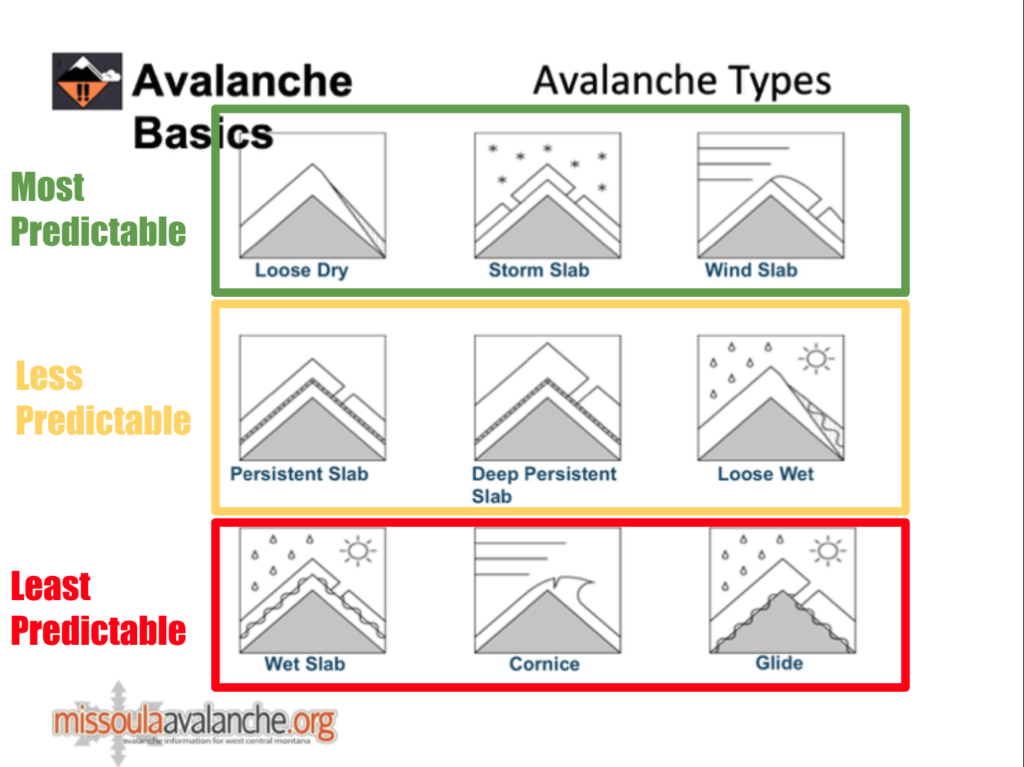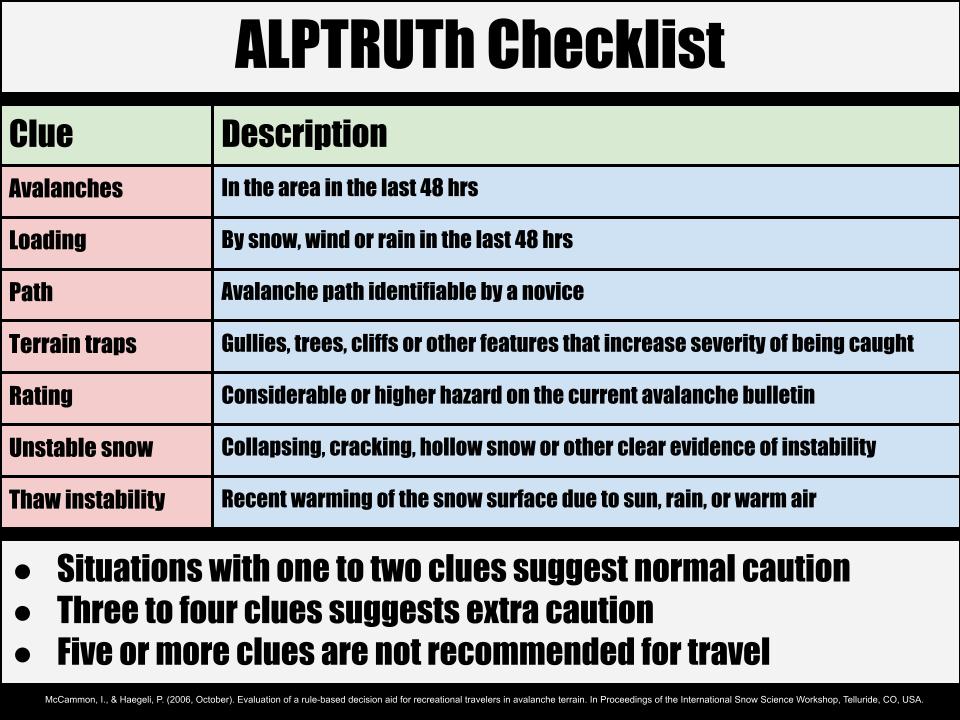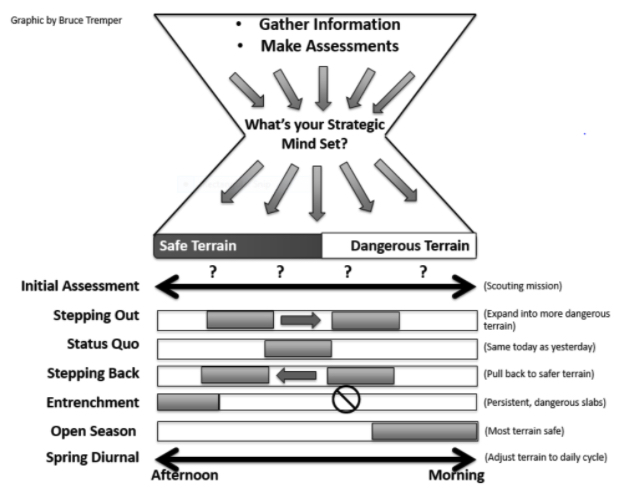April 8th marked the end of regular forecasts this season, but it does not mark the end of backcountry recreation. Many of you will continue to travel in avalanche terrain, potentially for months. The lack of a forecast does not mean that travel will be less safe, as long as you are practicing good risk assessment and decision making. This article offers advice and reminders to help you manage changing avalanche conditions and stay safe.
Spring can be a challenging time for avalanche conditions. Dramatic swings in weather and snow conditions are possible. Conditions can switch from mid-winter problems to wet snow problems within 24 hrs. Understanding avalanche problems can help us plan for successful days in the backcountry.
We have a decent understanding and tests for dry avalanche problems. We know that propagations within a weak layer can travel horizontally under a slab, delaminating it from the bed surface. If the slope’s steepness is enough to overcome the friction between the delaminated slab and the bed surface, we get an avalanche. This is why the extended column test is effective; it gives us an idea of the propagation likelihood.
Wet problems have less understood mechanics and predictability. Propagation is not the process that causes them and standard tests become ineffective. As snow warms up, it loses cohesion, and water is introduced into the snowpack. The weight of the water can cause the release of slab avalanches on lingering and dormant weak layers, and even the ground. Rollerballs (pinwheels) indicate water in the snowpack and signal that the snowpack is losing cohesion. Wet loose avalanches are the first to occur. Wet slab avalanches follow with continued warmth and water in the snowpack. The rate of thaw that results in a wet slab avalanche is variable and unpredictable.

We know that the snowpack is stable when it is refrozen, and stability decreases as it thaws. With repeated daily freeze and thaw, called the diurnal cycle, the snowpack gets more dense and stable. With this pattern, instabilities become isolated to the upper snowpack that melts daily. This changes when we receive new snow that delivers a new load or have multiple nights with above-freezing temperatures that allow the snowpack to thaw to the ground and move moisture into underlying weak layers. Rain will also quickly destabilize the snowpack.
When the snow is wet, we can’t use tests for stability assessments; we must rely on observations to make decisions. In general if there is a supportable crust, the snowpack is stable. If it warms to the point that you are sinking past mid boot in moist snow it is time to move to shadier aspects or lower angle slopes. Roller balls and small loose wet avalanches are a sign of deteriorating conditions. If the snow did not refreeze overnight, you are post holing in wet snow, or it is raining, large destructive avalanches are possible, and you should avoid avalanche terrain altogether.
A rule based system for decision making in the back country can simplify decision making with all avalanche problems. Trask Baughman, an educator with the West Central Montana Avalanche Foundation (WCMAF) explains:
With the conclusion of the 22-23 avalanche forecast season, you will have to gather and observe all necessary data to plan your adventures and make on-slope go or no-go decisions. Bruce Tremper, the author of Staying Alive in Avalanche Terrain, writes, “Good habits are what will save your life”. Having easy to use tools helps build those good habits and aids decision making in the complex, dynamic mountain environment. All backcountry users, regardless of experience, can use rule-based decision-making.
A powerful tool is ALPTRUTh, a mnemonic to help memorize and remember red flags and key terrain features. To utilize this tool, you note the factors and add them up. ALPTRUTh can be incorporated into a pre-trip checklist or a final check before committing to a slope. When 3 or 4 clues are present, extra caution and careful terrain management are needed (93% of accidents in North America have 3 or more factors present). If you have 5 or more factors present, it is recommended you push pause and carefully find an alternative path.

Avalanches, in the last 48 hours?
- Using resources like the Missoula Backcountry Facebook page and the WCMAC public observations page is an excellent place to find this information when planning your tour. When in the field, if you see avalanches on similar aspects and elevations that you want to ski, nature is screaming danger.
Loading, by snow, wind, or rain in the last 48 hours?
- Snow doesn’t like rapid changes; it takes time for it to settle and bond. Your pre-tour ritual should include looking at weather data for the last few days.
Path. Are you skiing an avalanche path?
- The “Path” in ALPTRUTh is for easily recognizable avalanche terrain. When choosing to ski avalanche terrain, it is essential to make sure no other factors are present and to use best travel practices like skiing one at a time.
Terrain Traps. Are there any terrain traps?
- Imagine the consequence of being caught. Any terrain features like gullies, trees, and cliffs will significantly increase the severity of being caught, even by a small loose wet slide.
Rating. Is the danger Considerable or higher hazard?
- Without an avalanche bulletin, assume the danger rating is considerable, and travel as though it is. With stable weather and the absence of red flags, you can reduce the danger rating to moderate after careful consideration. Often in a spring diurnal cycle, the danger starts at low in the morning and rises throughout the day.
Unstable Snow. Has there been any collapsing, cracking, or rollerballs?
- Recent avalanches, collapsing, and cracking are clear signs of avalanche potential. Careful decision-making and terrain choices are recommended.
Thaw Instability. Is the temperature rising?
- When temperatures rise above freezing, the snowpack’s cohesion quickly falls apart, leading to thaw instability. Keeping an eye on the time of day and rising temperatures is the name of the game in the spring. Looking at weather data to see if it is freezing at night will help give you a go or no-go decision before leaving your house.
In my assessment continuum, I rely on observing red flags and weather trends listed in ALPTRUTh first and using data from snow pits last. If ALPTRUTh is indicating dangerous conditions then pits and stability tests are unnecessary. Additionally, stability tests do not reliably predict wet problems. In any case, you should never use a single pit to make decisions when choosing to ski a slope. A quick hand pit can be helpful when investigating how saturated the snow surface is. Skiing a test slope is also a great way to gather information on surface conditions. When I decide that it is safe to ski avalanche terrain, I slowly step into more committing terrain in a systematic approach.
Roger Atkins’ Strategic Mindset is another great tool. More can be read here. We can simplify the decision-making process by deciding what sort of terrain we are willing to step into and what terrain to avoid, before entering the backcountry. For instance, if we decide that avalanches are possible in terrain over 35º, and we will stay out of that terrain, it removes quite a bit of the assessment process. If we decide to stick to terrain under 30º, it can eliminate almost all of the assessment process as less than 2% of all avalanches occur under 30º.

The public observations page is a great asset for learning and sharing about conditions. Public observations are an important source of information this time of year, keep them coming. They don’t need to be complex; anything is helpful, and pictures speak a thousand words. Pertinent negatives are also helpful; let people know if you didn’t see any red flags and found stable conditions. Road and skiing conditions are nice things to include as well.
Useful online resources:
- Weather
- The NOAA backcountry forecast page has a number of useful links, including local SNOTEL sites.
- The NOAA home page also has good info; check out the discussion for more detailed weather information.
- Montana MDT has Cams at Lolo, Lost Trail, and other roads, giving a visual of weather conditions.
- Snow-forecast.com Has good weather maps that show snowfall, freezing level, cloud cover, wind, etc.
Ski and ride safe. See you next year!























